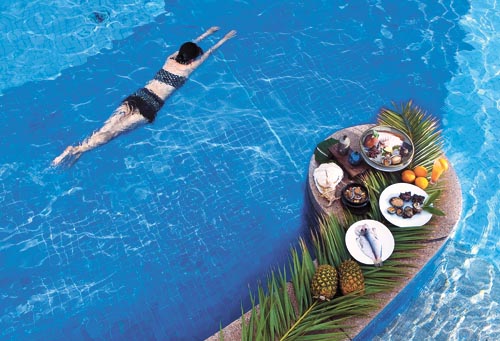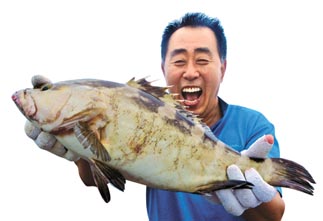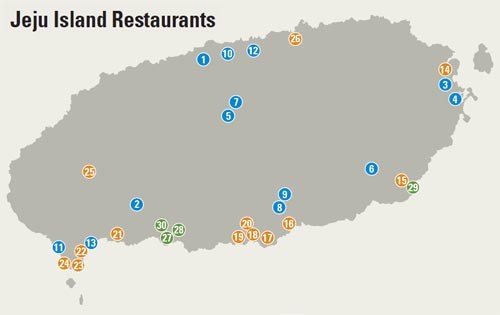Savor the flavor of Jeju Island cuisine

Jeju’s many restaurants offer a variety of unique dishes that are difficult to find on the mainland. By Kwon Hyeok-jae
JEJU - In Korea, you can’t talk about summer vacation without mentioning Jeju Island. The island, just south of the peninsula, is arguably the country’s most popular leisure spot, with the scenic Mount Halla, miles of beaches and newly installed Olle walking trails luring tourists there each year.
Last year, about 7.6 million people visited Jeju Island on vacation, according to the Jeju Special Self-Governing Provincial Tourism Association, with about 1.5 million people visiting between July and August. Meanwhile, the number of foreign and Korean tourists increases every year.
Among the island’s numerous attractions, it is the outdoor activities that take center stage. But as you’re hopping around from place to place, you’ll need to refuel and Jeju is nothing if not a paradise for the palate. The island is famous for its seafood, savory black pork and an endless variety of traditional dishes made with fresh island greens.
We set out to discover some of the island’s culinary delights, but with over 3,000 different restaurants to choose from, it was a very difficult job. So we asked for help from a group locals who have lived on the island for between 10 and 40 years, and we were able to narrow the list to 30 outstanding restaurants categorized as traditional, Olle Trail and hotel restaurants.
Traditional restaurants

This is also a good place to try mulhoe, a cold raw fish soup, which is one of the island’s most popular summer dishes. A typical mulhoe dish consists of slices of coralfish and raw mitra squid mixed with vegetables, spicy red pepper sauce and ice water.
Another restaurant famous for its mulhoe is Hanggu Sikdang, which has been around since 1964. Their soup is mixed with bean paste stew and vinegar.
Sambo Sikdang, which opened 25 years ago, offers the three famous Jeju Island dishes - coralfish mulhoe, broiled Jeju red snapper and abalone seafood soybean soup. In particular, the abalone and seafood soybean soup, boiled with fresh abalone and shrimp, is considered the best among the three by the locals. Another restaurant, Hwanggane Jeju Ttugbaegi, is also well-known for its seafood soup. And Apbengda Sikdang also offers a great, but different kind of fish soup boiled with anchovies and clams.
Jeju’s specialty is black pork. Tourists should, however, be aware that there are some restaurants selling ordinary pork as black pork.
One place that offers real black pork is Swineun Pang Garden, where reservations are recommended because all of the black pork sells out by around 4 or 5 p.m.
Olle Trail restaurants
“Olle” is a word in the Jeju dialect that refers to the narrow pathway connecting the street and the front gate of a house.
The word has since been appropriated to refer to a system of walking trails that now attract visitors from Korea and abroad. There are several good restaurants serving up traditional Korean food that have sprung up around the trails.
Siheung Haenyeo’s House, located at the trailhead of Olle Route 1, is a restaurant managed by a group of haenyeo, or female divers, from a small island village called Ohjo-ri. The porridge boiled with fresh abalone and clams collected by divers is highly recommended.
Mihyang Sikdang, located on Olle Route 10, offers a full course meal for 5,000 won ($4.70). The meal includes grilled fish and pork with seven other side dishes. The owner himself is a fisherman and he only uses fresh ingredients that he collects every day from the ocean. The clam jeongsik (a full course meal with grilled fish, clams and pork) is another popular item.
At Hyeongjedo Sikdang, which is also located on Olle Route 10, raw abalone and broiled hairtail fish is provided for free when you order a medium-sized mixed seafood soup.
Finally, Chunja Meulchi Guksu is considered a sacred place among Olle tourists. It is located at the end of Olle Route 3. Although some may consider the noodles with anchovies as somewhat ordinary, it is one of the best snacks on the trail because the island’s anchovies are known for their freshness.
Hotel restaurants
For upmarket meals, the island’s hotels offer elegance and style in a lovely setting.
The Jeju Shilla Hotel’s Camping Barbecue is particularly recommended. As the sun sets, one can pitch a tent in a hotel camping barbecue zone and settle in for a night under the stars while enjoying the taste of grilled black pork, fresh abalone, shrimp and beef.
At the Lotte Hotel in Jeju Lake Plaza, visitors can enjoy a buffet in the garden with the entertainment of a volcano fountain show that uses lasers and water screens. The show starts at 6:30 p.m. daily and lasts for about three hours. The buffet features 130 dishes, including salads, pasta, barbecue dishes and traditional foods from Jeju Island.
And Jeju Haevichi’s Korean and Japanese restaurant Hanoru offers a full course meal featuring sea bass this month and next.

1. Hwanggane Jeju Ttugbaegi (713-8887)
Obunjagi soup (blue abalone) (15,000 won / $14 ), Abalone soup (12,000 won)
2. Swineun Pang Garden (738-5833)
Jeju black pork belly (16,000 won), Jeju black pork neck (14,000 won)
3. Ojo Haenyeo’s House (784-7789)
Jeju abalone porridge (10,500 won), Jeju abalone hoe (raw fish) (130,000 won)
4. Yetnal Yetjeok (784-2252)
Braised Jeju hairtail fish (30,000 won), Dombegogi jeongsik (full course meal) with pork and red tile fish (30,000 won)
5. Apbengda Sikdang (744-7942)
Gakjaegi soup (Japanese mackerel) (6,000 won), Anchovy soup (6,000 won)
6. Namokdo Sikdang (787-1202)
Sundae soup (Korean blood sausage) (5,000 won), Pork belly (8,000 won)
7. Jamae Noodles (727-1112)
Noodles with meat (6,000 won), Noodles with anchovies and meat (6,000 won)
8. Sambo Sikdang (762-3620)
Coralfish mulhoe (raw fish soup) (8,000 won), Abalone seafood soybean soup (12,000 won), Broiled Jeju red snapper (23,000 won)
9. Yongyi Sikdang (732-7892)
Pork duruchigi (Korean bouillabaisse) (6,000 won)
10. Yubin (753-5218)
Abalone porridge (10,000 won), Sea urchin with seaweed soup (9,000 won)
11. Hanggu Sikdang (794-2254)
Coralfish mulhoe (7,000 won), Broiled coralfish (7,000 won)
12. Sanjimul Sikdang (752-5599)
Mulhoe (9,000 won), Braised jjichi (tile fish) (30,000 won to 40,000 won)
13. Namgyeongmirak (794-0055)
Raw sawedged perch (200,000 won for 1 kilogram), Raw black snapper (120,000 won for 1 kilogram)
Olle Trail restaurants
14. Siheung Haenyeo’s House (782-9230)
Abalone porridge (10,000 won), Clam porridge (7,000 won)
15. Chunja Meulchi Guksu (787-3124)
Noodles with anchovies (2,500 won)
16. UheoJin’s Hoetjib (732-7442)
Coralfish mulhoe (8,000 won), Mitra squid mulhoe (8,000 won)
17. Dolaon Cheonjiyeon Sikdang (762-7073)
Raw rudderfish (70,000 won), Mixed raw fish (60,000 won)
18. Neulgopang Sikdang (762-0849)
Char-grilled Jeju black pork belly (15,000 won)
19. Jeju Halmang Ttukbaegi (733-9934)
Broiled hairtail fish (9,000 won), Hairtail fish soup (25,000 won to 35,000 won)
20. Donghwan Sikdang (739-8644)
Coralfish mulhoe (8,000 won), Kimchi soup (6,000 won)
21. Red Brown (738-8288)
Cinnamon waffle set (13,000 won), Hand-drip coffee (5,000~6,000 won)
22. Hyeongjedo Sikdang (792-3402)
Boiled mixed seafood soup (45,000 won to 55,000 won)
23. Mihyang Sikdang (794-5558)
Jeongsik with grilled fish and pork (5,000 won)
24. Sanbang Sikdang (794-2156)
Cold buckwheat noodles (5,000 won), Boiled pork (8,000 won)
25. Myeonglidong Sikdang (772-5571)
Assorted grilled meat (12,000 won per 300 grams), Jeongsik (6,000 won)
26. Dongbokri Haenyeochon (783-5438)
Noodles with raw fish (7,000 won), Sea urchin noodles (7,000 won)
Hotel restaurants
27. Jeju Shilla Hotel (735-5179)
Camping barbecue lunch (70,000 won) or dinner (75,000 won)
28. Lotte Hotel at Jeju Lake Plaza (731-4264)
Volcano Fountain Show and Outdoor Buffet (36,000 won for children ages 4 to 13 and 65,000 won for adults, excluding tax)
29. Jeju Haevichi Hanoru (780-8311)
Sea bass full course meal (85,000 won, excluding tax)
30. Hyatt Regency Jeju (733-1234)
Barbecue buffet (31,000 won for elementary students and 52,000 won for adults, excluding tax)
*All phone numbers start with the prefix 064.
By Yoon Seoh-yun [estyle@joongang.co.kr]
한글 관련 기사 [중앙일보]
자리물회·옥돔구이·해물뚝배기 제주 3보 꼭 맛봅서
제주도에는 음식점이 3000개가 넘는다고 한다. 이 중에서 30곳을 선정하기란 쉬운 일이 아니었다. 그래서 더 심사숙고했다. 제주 토박이들에게 짧게는 10년, 길게는 40년의 내공을 지닌 제주 전통 맛집과, 올레꾼들에게 사랑받는 올레 주변 맛집을 추천받았다. 이 중 현장 취재를 거쳐 각각 13곳씩 엄선했다. 여기에 야외수영장에서 선탠하고 스파에서 몸 풀며 하루 종일 호텔에 머무르는 ‘릴랙스족’을 위해 호텔 맛집 네 군데도 추렸다. 그렇게 완성한 ‘제주 맛집 30선’ 지도. 인터넷으로 ‘제주 맛집’ 검색할 필요 없이 이 지도만 챙겨서 가면 된다.
전통 맛집
제주에 가서 회를 맛보지 않을 수 없다. 제주산 활어회만을 취급하는 ‘남경미락’은 김영삼 전 대통령, 빌 클린턴 전 미국 대통령, 반기문 유엔 사무총장도 다녀간 곳이다. 두툼하게 썬 다금바리회도 일품이지만, 용머리 해안과 산방산이 한눈에 들어오는 전망이 환상적이다.
1㎏에 20만원을 호가하는 남경미락의 다금바리회가 부담스럽다면 물회는 어떨까. 지금 한창 제철인 자리돔회나 한치회에 각종 채소와 양념장·얼음물을 넣어 먹는 물회는 제주의 대표 여름음식이다. 1964년 문을 연 ‘항구식당’이 물회로 유명하다. 뼈째 썬 자리돔회와 된장·식초 맛이 강한 양념국물이 어우러진 자리물회 한 그릇에 더위가 싹 가신다.
25년째 한 자리를 지키고 있는 ‘삼보식당’은 제주 맛의 세 가지 보물, 삼보(三寶)를 내놓는다. 자리물회·옥돔구이·해물뚝배기가 그것이다. 이 중에서도 오분자기·전복·새우를 듬뿍 넣어 끓인 해물뚝배기가 가장 인기가 많다. 24년 역사를 자랑하는 ‘황가네 제주뚝배기’의 오분자기뚝배기와 비교하며 먹어보는 것도 좋을 듯하다. 전갱이와 멸치를 넣고 끓인 ‘앞뱅디식당’의 각제기국과 멜국도 이 두 뚝배기에 뒤지지 않는 시원한 국물 맛을 자랑한다.
한편 일반 돼지고기를 제주산 흑돼지고기로 둔갑시켜 파는 식당이 있어 주의해야 한다. ‘쉬는 팡 가든’은 진짜 제주산 흑돼지고기를 맛볼 수 있는 대표적인 곳이다. 왕소금을 솔솔 뿌린 흑돼지 오겹살을 솥뚜껑에 구워 먹는 맛이 기가 막히다. 오후 4~5시에 고기가 다 팔리는 경우가 많으니 미리 확인하고 가는 것이 좋다.
올레 맛집
올레길을 걷게 되면 올레 맛집도 알아야 한다. 올레길은 되바라진 관광지보다 한적한 마을을 헤집고 다녀 제주 사람만 찾아다니던 전통 맛집과 자주 만나게 된다. 1코스 시작점에 자리한 ‘시흥해녀의 집’은 오조리 어촌계 해녀들이 운영하는 곳이다. 해녀들이 갓 잡아 올린 전복과 조개로 끓인 죽이 일품이다. 인원수보다 한 그릇 적게 시켜 먹어도 양이 충분하다.
10코스에 있는 ‘미향식당’은 5000원짜리 정식을 시키면 벵에돔구이·짜투리 돼지고기구이·자리돔젓갈과 달걀말이를 비롯한 7가지 밑반찬이 나온다. 매일 아침 주인 아저씨가 바다에 나가 잡아오는 신선한 재료만 쓴다. 지금 한창 살이 오른 보말(고둥의 제주도 말)로 차린 보말정식도 인기다. 같은 10코스의 ‘형제도식당’에서는 해물전골 중짜 하나를 시키면 4인 가족이 배불리 먹을 수 있다. 전골냄비에 소라·새우·가리비·게 등이 넘칠 정도로 담겨 나오고, 생전복과 옥돔구이는 서비스다.
올레꾼 사이에서 성지처럼 떠받들어지는 곳도 있다. 3코스가 끝나는 지점 표선면사무소 앞에 있는 ‘춘자멸치국수’다. 양은 냄비에 담겨 나오는 평범한 멸치국수이지만 지친 올레꾼에게 훌륭한 간식이 되면서 명소가 됐다. 올레길 위 수퍼마다 파는 ‘올레꿀빵(1개 1000원)’은 일종의 ‘올레 비상식량’이다. 팥 앙금이 들어간 빵을 튀긴 뒤 설탕시럽을 입힌 것으로 올레 대표 간식으로 통한다. 단맛이 강해 한 개 이상 먹기는 힘들지만, 올레길 위에서 허기를 달래는 데는 최고다.
호텔 맛집
호텔마다 꼭 맛봐야 하는 메뉴가 따로 있다. 제주신라호텔은 캠핑 바비큐를 꼽을 수 있다. 어둑어둑 해가 지면 넓은 잔디밭이 펼쳐진 호텔 내 캠핑 바비큐 존에 텐트를 치고, 제주산 흑돼지·전복·새우·LA갈비 등을 그릴에 직접 구워 먹는다. 음식 맛도 맛이지만 실제로 제주의 한 숲에 야영을 온 듯 무수한 별들을 보며 밤을 보내는 재미가 크다.
롯데호텔제주에서는 화산 분수쇼를 보며 뷔페를 즐길 수 있다. 매일 오후 6시30분부터 세 시간 동안 호텔 내 야외정원에 워터스크린과 레이저를 이용한 화산 분수쇼와 함께 130여 가지의 음식이 차려진다. 각종 샐러드와 파스타·바비큐 메뉴 외에 보말죽·돔베고기·오메기떡 등 제주 토속음식도 가득하다.
제주해비치호텔의 한일식당 ‘하노루’는 다음 달 31일까지 구문쟁이 특선을 선보인다. 다금바리의 사촌 격인 구문쟁이는 다금바리보다 값이 싸면서 못지않게 맛이 좋다. 이번 기회에 구문쟁이를 회·구이·지리(맑은 국) 등으로 다양하게 즐길 수 있다.










with the Korea JoongAng Daily
To write comments, please log in to one of the accounts.
Standards Board Policy (0/250자)